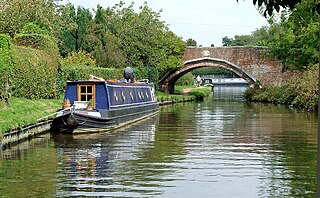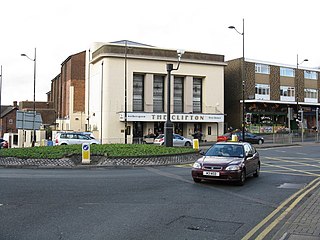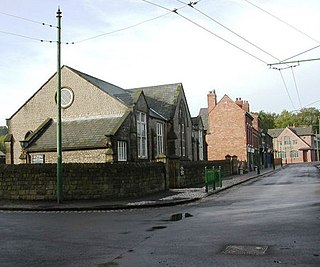Related Research Articles

South Staffordshire is a local government district in Staffordshire, England. Its council is based in Codsall. Other notable settlements include Brewood, Cheslyn Hay, Coven, Essington, Featherstone, Four Ashes, Great Wyrley, Huntington, Kinver, Landywood, Penkridge, Perton, Wedges Mills, Weston-under-Lizard and Wombourne. The district covers a largely rural area lying immediately to the west and north-west of the West Midlands conurbation.

Sedgley is a town in the north of the Dudley district, in the county of the West Midlands, England.

Penn is an area divided between the City of Wolverhampton and South Staffordshire district. The population of the Wolverhampton Ward taken at the 2011 census was 12,718. Originally, it was a village in the historic county of Staffordshire.

Coseley is a village in the Dudley district, in the county of the West Midlands, England. It is situated three miles north of Dudley itself, on the border with Wolverhampton and Sandwell. It falls within the Tipton and Wednesbury parliamentary constituency.

Blakenhall is a suburb and ward in Wolverhampton, England. The population was 12,614 at the 2021 census.

Richard Challoner was an English Catholic prelate who served as Vicar Apostolic of the London District during the greater part of the 18th century, and as Titular Bishop of Doberus. In 1738, he published a revision of the Douay–Rheims Bible.

Cotton College was a Roman Catholic boarding school in Cotton, Staffordshire, United Kingdom. It was also known as Saint Wilfrid's College.
Goldthorn Park is a suburb of Wolverhampton, West Midlands. It is situated 1½ miles south of the city centre within the Blakenhall ward. It mostly consists of private houses built from the 1930s onwards.

Ettingshall is an area of Wolverhampton, West Midlands, England. It lies within two wards of Wolverhampton City Council: Ettingshall North and Ettingshall South and Spring Vale. The population of Ettingshall taken at the 2011 census was 13,482.
Sedgley urban district was a local government district within Staffordshire, which was created in 1894 from the western half of the manor of Sedgley.
John Joseph Hornyold was an English Catholic bishop, titular Bishop of Phiomelia, and Vicar Apostolic of the Midland District, England for twenty-two years.
William Errington was an English Roman Catholic priest, and founder of Sedgley Park School.

Eve Hill is a residential area of Dudley in the West Midlands of England. It was part of Worcestershire until 1966 and briefly part of Staffordshire until 1974.

Gornal is a village and electoral ward in the Dudley Metropolitan Borough, in the West Midlands of England. It encompasses the three historical villages of Upper Gornal, Lower Gornal, and Gornal Wood. Gornal was historically part of Staffordshire, prior to the creation of the West Midlands County in 1974. Gornal is 11 miles from Birmingham.

Cotton is a village and civil parish in Staffordshire, England. It is about 5 miles (8.0 km) north-east of Cheadle.
Colton Hills Community School is a mixed secondary school and sixth form situated in the Goldthorn Park area of Wolverhampton, West Midlands, England.
Thomas Smith was an English Catholic prelate who served as the Vicar Apostolic of the Northern District from 1821 to 1831.
John McIntyre was an English prelate who served as the Roman Catholic Archbishop of Birmingham from 1921 to 1928.
Woodsetton is an area of the Dudley Metropolitan Borough in the West Midlands of England, roughly 2.0 miles (3 km) northwest of Dudley Town Centre. Formerly in the Sedgley Urban District, a part of Woodsetton was transferred into the Dudley County Borough in 1926 to allow for the building of the Priory Estate. This reorganisation also saw this part of the area transferred from Staffordshire to Worcestershire.
Bishop Milner Catholic College is a Roman Catholic secondary school and sixth form with academy status, located in the Eve Hill area of Dudley, West Midlands, England. Enrolment includes students who live beyond Dudley's borders, mostly in Sandwell. The college also has enrolled a number of non-Catholic pupils.
References
- ↑ "Records of Sedgley Park School, Wolverhampton, and Cotton College, Oakamoor, Staffordshire". Archives hub. Retrieved 24 June 2011.
- 1 2 Husenbeth D.D., F.C., The History of Sedgley Park School, London, Richardson and Son, 1856
 This article incorporates text from this source, which is in the public domain .
This article incorporates text from this source, which is in the public domain . - 1 2 Burton, Edwin. "William Errington." The Catholic Encyclopedia Vol. 5. New York: Robert Appleton Company, 1909. 14 January 2019
 This article incorporates text from this source, which is in the public domain .
This article incorporates text from this source, which is in the public domain . - ↑ "Our History". Wolverhampton: Park Hall Hotel & Spa. Retrieved 24 March 2023.